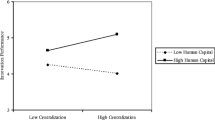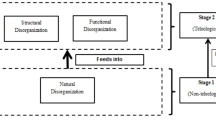Abstract
Organizational change in emerging economies, although difficult, is inevitable. The authors study the drivers and consequences of organizational changes in an emerging economy, China. The results of a firm-level survey show that organizational changes in technical vs administrative areas are differentially driven by firms' motivation to change (past performance), opportunity to change (firm location and market orientation), and capability to change (firm ownership, managers' change attitude, and leader charisma). Furthermore, technical and administrative changes affect firm performance through distinct paths. Technical changes have a direct, positive impact on performance, whereas administrative changes enhance firm performance indirectly through technical changes, and the effect of administrative changes on performance is strengthened by the presence of a participative culture.

Similar content being viewed by others
References
Allison, G. (1971) The Essence of Decision, Wiley: New York.
Amburgey, T.L., Kelly, D. and Barnett, W.P. (1993) ‘Resetting the clock: the dynamics of organizational change and failure’, Administrative Science Quarterly 38 (1): 51–73.
Anderson, J.C. and Gerbing, D.W. (1988) ‘Structural equation modeling in practice: a review of recommended two-step approach’, Psychological Bulletin 103 (3): 411–423.
Awamleh, R. and Gardner, W.L. (1999) ‘Perceptions of leader charisma and effectiveness: the effects of vision content, delivery, and organizational performance’, Leadership Quarterly 10 (3): 345–373.
Bass, B.M. and Avolio, B.J. (1994) Improving Organizational Effectiveness Through Transformational Leadership, Sage: Thousand Oaks, CA.
Boisot, M. and Child, J. (1996) ‘From fiefs to clans and network capitalism: explaining China's emerging economic order’, Administrative Science Quarterly 41 (4): 600–628.
Brown, J.S. and Duguid, P. (1991) ‘Organizational learning and communities-of-practice: toward a unified view of working, learning, and innovation’, Organization Science 2 (1): 40–57.
Brown, S.L. and Eisenhardt, K.M. (1997) ‘The art of continuous change: linking complexity theory and time-paced evolution in relentlessly shifting organizations’, Administrative Science Quarterly 42 (1): 1–34.
Child, J. and Tse, D.K. (2001) ‘China's transition and its implications for international business’, Journal of International Business Studies 32 (1): 5–21.
Damanpour, F. (1991) ‘Organizational innovation: a meta-analysis of effects of determinants and moderators’, Academy of Management Journal 34 (3): 555–590.
Damanpour, F. and Evan, W.M. (1984) ‘Organizational innovation and performance: the problem of ‘organizational lag’’, Administrative Science Quarterly 29 (3): 392–409.
D'Aunno, T., Succi, M. and Alexander, J.A. (2000) ‘The role of institutional and market forces in divergent organizational change’, Administrative Science Quarterly 45 (4): 679–703.
Day, G.S. (1994) ‘The capabilities of market-driven organizations’, Journal of Marketing 58 (4): 37–52.
Day, G.S. and Wensley, R. (1988) ‘Assessing advantage: a framework for diagnosing competitive superiority’, Journal of Marketing 52 (2): 1–20.
Denison, D.R. (2001) Managing Organizational Change in Transition Economies, Lawrence Erlbaum: Mahwah, NJ.
Deshpande, R. and Webster, F.E. (1989) ‘Organizational culture and marketing: defining the research agenda’, Journal of Marketing 53 (1): 3–15.
Feldman, M.S. (2004) ‘Resources in emerging structures and processes of change’, Organization Science 15 (3): 295–309.
Fornell, C. and Larker, D.F. (1981) ‘Evaluating structural equations models with unobservable variables and measurement error’, Journal of Marketing Research 18 (1): 39–50.
Ginsberg, A. and Buchholtz, A. (1990) ‘Converting to for-profit status: corporate responsiveness to radical change’, Academy of Management Journal 33 (3): 445–477.
Goodstein, J. and Boeker, W. (1991) ‘Turbulence at the top: a new perspective on governance structure changes and strategic change’, Academy of Management Journal 34 (2): 306–330.
Granovetter, M. (1985) ‘Economic action and social structure: the problem of embeddedness’, American Journal of Sociology 91 (3): 481–510.
Greenwood, R. and Hinings, C.R. (1996) ‘Understanding radical organizational change: bringing together the old and the new institutionalism’, Academy of Management Review 21 (4): 1022–1054.
Greve, H.R. (1998) ‘Performance, aspirations, and risky organizational change’, Administrative Science Quarterly 43 (1): 58–86.
Han, J.K., Kim, N. and Srivastava, R.K. (1998) ‘Market orientation and organizational performance: is innovation a missing link?’ Journal of Marketing 62 (4): 30–45.
Hannan, M.T. and Freeman, J.H. (1984) ‘Structural inertia and organizational change’, American Sociological Review 49 (2): 149–164.
Haveman, H.A. (1992) ‘Between a rock and a hard place: organizational change and performance under conditions of fundamental environmental transformation’, Administrative Science Quarterly 37 (1): 48–75.
Hill, G.W. (1982) ‘Group versus individual performance: are N+1 heads better than one?’ Psychological Bulletin 91 (3): 40–46.
Hoskisson, R.E., Eden, L., Lau, C.M. and Wright, M. (2000) ‘Strategy in emerging economies’, Academy of Management Journal 43 (3): 249–267.
House, R.J., Spangler, W.D. and Woycke, J. (1991) ‘Personality and charisma in the US presidency: a psychological theory of leadership effectiveness’, Administrative Science Quarterly 36 (3): 364–396.
Huber, G.P. (1991) ‘Organizational learning’, Organization Science 2 (1): 88–115.
Hurley, R.F. and Hult, T.M. (1998) ‘Innovation, market orientation, and organizational learning: an integration and empirical examination’, Journal of Marketing 62 (3): 42–54.
James, L.R. (1982) ‘Aggregation bias in estimates of perceptual agreement’, Journal of Applied Psychology 67 (2): 219–229.
Jaworski, B.J. and Kohli, A.K. (1993) ‘Market orientation: antecedents and consequences’, Journal of Marketing 57 (3): 53–70.
Keister, L.A. (2002) ‘Adapting to radical change: strategy and environment in piece-rate adoption during China's transition’, Organization Science 13 (5): 459–474.
Kotabe, M. and Murray, J.Y. (1990) ‘Linking product and process innovations and modes of international sourcing in global competition: a case of foreign multinational firms’, Journal of International Business Studies 21 (3): 383–408.
Kotter, J.P. (1995) ‘Leading change: why transformation efforts fail’, Harvard Business Review 2: 59–67.
Lau, C.M., Tse, D.K. and Zhou, N. (2002) ‘Institutional forces and organizational culture in China: effects on change schemas, firm commitment and job satisfaction’, Journal of International Business Studies 33 (3): 533–550.
Lau, C.M. and Woodman, R.W. (1995) ‘Understanding organizational change: a schematic perspective’, Academy of Management Journal 38 (2): 537–554.
Levinthal, D.A. (1991) ‘Organizational adaptation and environmental selection’, Organizational Science 2 (1): 140–144.
Levinthal, D.A. and March, J.G. (1993) ‘The myopia of learning’, Strategic Management Journal 14 (Winter Special Issue): 95–112.
March, J.G. (1991) ‘Exploration and exploitation in organizational learning’, Organization Science 2 (1): 71–87.
Matsuno, K., Mentzer, J. and Özsomer, A. (2002) ‘The effects of entrepreneurial proclivity and market orientation on business performance’, Journal of Marketing 66 (3): 18–32.
Miller, D. and Chen, M.J. (1994) ‘Sources and consequences of competitive inertia: a study of the US airline industry’, Administrative Science Quarterly 39 (1): 1–23.
Mullen, M.R. (1995) ‘Diagnosing measurement equivalence in cross-national research’, Journal of International Business Studies 26 (3): 573–596.
Murray, J.Y., Kotabe, M. and Wildt, A.R. (1995) ‘Strategic and financial performance implications of global sourcing strategy: a contingency analysis’, Journal of International Business Studies 26 (1): 181–202.
Nadler, D.A. and Tushman, M.L. (1990) ‘Beyond the charismatic leader: leadership and organizational change’, California Management Review 32 (2): 77–97.
Nee, V. (1992) ‘Organizational dynamics of market transition: hybrid forms, property rights and mixed economy in China’, Administrative Science Quarterly 37 (1): 1–27.
Park, S.H. and Luo, Y. (2001) ‘Guanxi and organizational dynamics: organizational networking in Chinese firms’, Strategic Management Journal 22 (5): 455–477.
Peng, M.W. (2003) ‘Institutional transitions and strategic choices’, Academy of Management Review 28 (2): 275–296.
Peng, M.W. and Heath, P.S. (1996) ‘The growth of the firm in planned economies in transition: institutions, organizations, and strategic choice’, Academy of Management Review 21 (2): 492–528.
Pettigrew, A.M., Woodman, R.W. and Cameron, K.S. (2001) ‘Studying organizational change and development: challenges for future research’, Academy of Management Journal 44 (4): 697–713.
Piderit, S.K. (2000) ‘Rethinking resistance and recognizing ambivalence: a multidimensional view of attitudes toward an organizational change’, Academy of Management Review 25 (4): 783–794.
Ping, R.A. (1995) ‘A parsimonious estimating technique for interaction and quadratic latent variables’, Journal of Marketing Research 32 (3): 336–347.
Porter, M.E. (1985) Competitive Advantage, The Free Press: New York.
Quinn, R.E. (1988) Beyond Rational Management, Jossey-Bass: San Francisco.
Rajagopalan, N. and Spreitzer, G.M. (1996) ‘Toward a theory of strategic change: a multi-lens perspective and integrative framework’, Academy of Management Review 22 (1): 48–79.
Roberts, P.W. (1999) ‘Product innovation, product-market competition and persistent profitability in the US pharmaceutical industry’, Strategic Management Journal 20 (6): 655–670.
Slater, S.F. and Narver, J.C. (1995) ‘Market orientation and the learning organization’, Journal of Marketing 59 (3): 63–74.
Starbuck, W.H. and Milliken, F.J. (1988) ‘Challenger: fine-tuning the odds until something breaks’, Journal of Management Studies 25 (4): 319–340.
Tse, D.K., Francis, J. and Walls, J. (1994) ‘Cultural differences in conducting intra- and inter-cultural negotiations: a Sino-Canadian comparison’, Journal of International Business Studies 25 (3): 537–555.
Tsoukas, H. (1996) ‘The firm as a distributed knowledge system: a constructionist approach’, Strategic Management Journal 17 (1): 11–26.
Tsoukas, H. and Chia, R. (2002) ‘On organizational becoming: rethinking organizational change’, Organizational Science 13 (5): 567–582.
Tushman, M.L. and Anderson, P. (1986) ‘Technological discontinuities and organizational environments’, Administrative Science Quarterly 31 (3): 439–465.
Tushman, M.L. and Romanelli, E. (1985) ‘Organizational Evolution: A Metamorphosis Model of Convergence and Reorientation’, in L.L. Cummings and B.M. Staw (eds.) Research in Organizational Behavior, Vol. 7 JAI Press: Greenwich, CT, pp: 171–222.
Van Bruggen, G.H., Lilien, G.L. and Kacker, M. (2002) ‘Informants in organizational marketing research: why use multiple informants and how to aggregate responses’, Journal of Marketing Research 34 (4): 469–478.
Weick, K.E. and Quinn, R.E. (1999) ‘Organizational change and development’, Annual Review of Psychology 50: 361–386.
Zajac, E.J. and Kraatz, M.S. (1993) ‘A diametric model of strategic change: assessing the antecedents and consequences of restructuring in the higher education industry’, Strategic Management Journal 14 (2): 83–102.
Zhou, K.Z., Yim, C.K. and Tse, D.K. (2005) ‘The effects of strategic orientations on technology- and market-based breakthrough innovations’, Journal of Marketing 69 (2): 42–60.
Acknowledgements
This study was supported by a research grant from the University of Hong Kong and a grant from the Research Grants Council, Hong Kong SAR Government (CERG CityU 1176/97H). We thank the Departmental Editor, Professor Charles Galunic and the two anonymous JIBS reviewers for their insightful and constructive comments.
Author information
Authors and Affiliations
Corresponding author
Additional information
Accepted by Charles Galunic, Departmental Editor, 29 June 2005. This paper has been with the author for two revisions.
Appendix
Rights and permissions
About this article
Cite this article
Zhou, K., Tse, D. & Li, J. Organizational changes in emerging economies: drivers and consequences. J Int Bus Stud 37, 248–263 (2006). https://doi.org/10.1057/palgrave.jibs.8400186
Received:
Revised:
Accepted:
Published:
Issue Date:
DOI: https://doi.org/10.1057/palgrave.jibs.8400186




